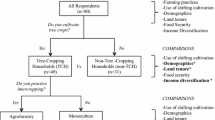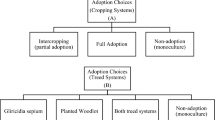Abstract
In an effort to assess agroforestry adoption potential among a diverse Pennsylvania landowner population, a mail survey instrument was sent to 250 members of the Pennsylvania Association of Sustainable Agriculture (PASA) and 250 members of Woodland Owner Associations (WOA). Current management objectives and production strategies, agroforestry awareness, agroforestry interest, and perceptions regarding the benefits and obstacles to agroforestry adoption were gauged. Market segmentation was performed with a two-step cluster analysis to produce four agroforestry adoption potential models: Timber-Related Practices, Livestock-Related Practices, Specialty Crop-Related Practices, and Non-Adopters. The analyses showed that agroforestry practices could indeed satisfy specific land management objectives within diverse populations. The key to outreach success and adoption will be to engage these landowner groups according to their unique interests and values, and to demonstrate the potential agroforestry has to enhance existing objectives.
Similar content being viewed by others
References
Chamberlain J.L., Bush R., Hammett A.L. and Araman P.A. 2002. Managing for nontimber products. J. For., Jan/Feb. pp. 8–14.
D.W. Cravens (1997) Strategic Marketing EditionNumber5 Irwin Publishers Homewood
M. Crimp (1981) The Marketing Research Process Prentice Hall International Englewood Cliffs, NJ
D. Dillman (2000) Mail and Internet Surveys: The Tailored Design Method EditionNumber2 Wiley New York
Emery M.R. 2002. Historical overview of nontimber forest product uses in the Northeastern United States. In: Jones E.T. etal (ed.) Nontimber Forest Products in the United States. University Press of Kansas, pp. 3–25.
J.D. Esseks R.J. Moulton (2000) Evaluating the Forest Stewardship Program through a National Survey of Participating Forest Land Owners Northern Illinois University, Social Science Research Institute, Center for Governmental Studies De KalbIllinois 111
S. Franzel S.J. Scherr (2002) Trees on the Farm: Assessing the adoption potential of agroforestry practices in Africa CABI Publishing College Park
S. Franzel R. Cope P. Cooper F. Place S.J. Scherr (2001) ArticleTitleAssessing the adoption potential of agroforestry practices in sub-Saharan Africa Agricult. Syst. 69 IssueID1 37–62 Occurrence Handle10.1016/S0308-521X(01)00017-8
Garrett H. 1995. Temperate-zone Agroforestry Opportunities for the 21st Century and Beyond. From Proceedings: Fourth North American Agroforestry Conference, July 23–28, BoiseIdaho, pp. 3–5.
P. Goering H. Norberg-Hodge J. Page (1993) From the Ground Up: Rethinking Industrial Agriculture Zed Books London
Greene J., Daniels S., Jacobson M., Kilgore M. and Straka T. 2005. Existing and Potential Incentives for Practicing Sustainable Forestry on Non-Industrial Private Forest Lands. Final Report to the National Commission on Science for Sustainable Forestry NCSSF Research Project C2.
Harmon R. 2003. Forest Landowner Associations. The Pennsylvania Forest Stewardship Program. Accessed August 30, 2004. http://vip.cas.psu.edu/associations.html.
W. Jackson (2002) ArticleTitleNatural systems agriculture: a truly radical alternative Agricult. Ecosyst. Environ. 88 IssueID1 111–117 Occurrence Handle10.1016/S0167-8809(01)00247-X
Kaine G. and Niall E. 1999. Market Segmentation and Wet Soils Management. Final Report prepared for Wet Vic Dairy, Warrambool. 33pp. Accessed 24 April, 2003. http://www.une.edu.au/feb1/MARKETING/wetland.htm.
McKenzie-Mohr D. W. Smith (1999) Fostering Sustainable Behavior: An Introduction to Community-Based Social Marketing New Society Publishers Gabriola Island, BC
Nowak J., Blount A. and Workman S. 2002. Integrated Timber, Forage, and Livestock Production - Benefits of Silvopasture. University of Florida Cooperative Extension, CIRC 1430.
InstitutionalAuthorNamePennsylvania Department of Agriculture (2003) Farmland Preservation: Pennsylvania is the Leader. 2002–2003 Annual Report to the General Assembly Harrisburg
Pennsylvania Department of Community and Economic Development (PDCED) 2003. Annual Report on Land Use, 2002. Harrisburg.
M. Silver (1995) ArticleTitleScales of measurement and cluster analysis: an application concerning market segments in the babyfood market The Statistician 44 IssueID1 101–112 Occurrence Handle10.2307/2348621
J. Stevens (2002) Applied Multivariate Statistics for the Social Sciences EditionNumber4 Lawrence Erlbaum Associates Mahwah, NJ
Teel T.W. and Buck L.E. 2002. Between wildcrafting and monocultures: Agroforestry Options. In: Jones E.T. etal (ed.) Nontimber Forest Products in the United States. University of Kansas Press.
P.B. Thompson (2001) ArticleTitleThe Reshaping of Conventional Farming: A North American Perspective J. Agricult. Environ. Ethics 14 IssueID2 217–229 Occurrence Handle10.1023/A:1011388424793
United States Department of Agriculture (USDA). 2005. NRCS Conservation Programs. Accessed on November 11, 2005 at http://www.nrcs/usda.gov/programs/ .
United States Department of Agriculture (USDA). 2005. Sustainable Agriculture Research and Education (SARE) Grants. Accessed on November 1, 2005 at: http://www/sare.org.
M. Wedel W. Kamkura (2000) Market Segmentation: Conceptual and Methodological Foundations Kluwer Academic Publishers, Inc. London
A. Weinstein (1987) Market Segmentation: Using Demographics, Psychographics and other Segmentation Techniques to Uncover and Exploit Markets Probus Publishing Company Chicago
P.A. Williams A.M. Gordon H.E. Garrett L. Buck (1997) Agroforestry in North America and its role in farming systems A.M. Gordon S.M. Newmand (Eds) Temperate Agroforestry Systems CAB International NY 9–71
Workman S.W., Long A.J., Mohan S. and Monroe M.C. 2002. Agroforestry: Options for Landowners. University of Florida Cooperative Extension FOR 104.
Author information
Authors and Affiliations
Corresponding author
Rights and permissions
About this article
Cite this article
Strong, N., Jacobson, M.G. A case for consumer-driven extension programming: agroforestry adoption potential in Pennsylvania. Agroforest Syst 68, 43–52 (2006). https://doi.org/10.1007/s10457-006-0002-x
Received:
Accepted:
Issue Date:
DOI: https://doi.org/10.1007/s10457-006-0002-x




